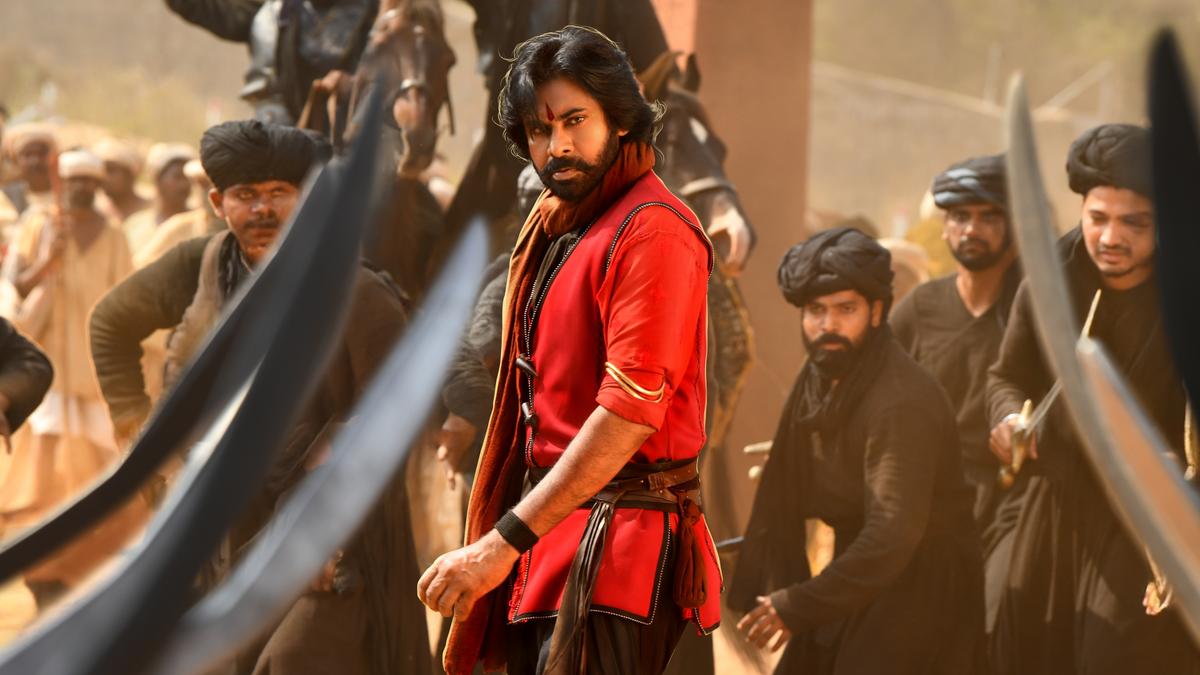Hari Hara Veera Mallu – Part 1: Sword Vs Spirit, with the tagline ‘battle for dharma’, was in the making for over five years. The delay was partly due to the pandemic, and later, the lead actor Pawan Kalyan taking on his role as Deputy Chief Minister of Andhra Pradesh. The film, originally directed by Krish Jagarlamudi, changed hands midway, with A M Jyothi Krishna stepping in to see it through. The shift is visible on screen.
This period drama, blending fact and fiction, often loses its way and feels stretched.
Pawan Kalyan plays Veera Mallu, a rebel who steals from the rich and helps the poor. The film takes creative liberties to build a fictional story, leaning into the actor’s public image and his alignment with sanatana dharma.
Hari Hara Veera Mallu: Part 1 (Telugu)
Direction: Jyothi Krishna and Krish Jagarlamudi
Cast: Pawan Kalyan, Nidhhi Agerwal, Bobby Deol, Sathyaraj
Run time: 162 minutes
Story: An outlaw, Veera Mallu, is tasked with retrieving the Kohinoor from the Mughals. He has other plans.
Kalyan refers to himself as a jana sevakudu, a nod to his political outfit, the Jana Sena Party. On screen, he plays the familiar son-of-the-soil figure — a saviour of the oppressed. In the run-up to the release, the makers shared that his character drew inspiration from actor-turned-politicians NT Rama Rao and MG Ramachandran, known for championing social causes in their films.
As the story unfolds, this persona is further underlined. Veera Mallu is sent to retrieve the Kohinoor from Aurangzeb’s (Bobby Deol) peacock throne. He is no common thief. His mission is tied to protecting Hindus, who are shown being forced to pay the jizya tax to practise their faith. To an extent, the film avoids turning this into a polarised ‘us versus them’ narrative. Two of Veera Mallu’s trusted aides are Muslims. The villain here is clearly Aurangzeb. While this approach might echo current political sentiments, the film does not offer the emotional depth to keep us truly engaged.
The narrative begins in 1650 AD at the Kolluru mines near the Krishna river. Starving labourers stumble upon precious stones, but go hungry, jostling for favour among their superiors. When a young miner asks if their lives have any worth, the response lays bare the hierarchy — local landlords, then the Qutb Shahis, and finally the Mughals.
Veera Mallu’s entry is staged in a manner reminiscent of Baahubali. But it is a weak imitation. Think of Sivagami and baby Baahubali in the turbulent river. This one tries something similar, but lacks the creative punch.
The first half drags along, saved occasionally by M.M. Keeravani’s music. While the story feels patchy, a couple of action scenes show Veera Mallu’s knack for stealing diamonds and standing up for the oppressed. A wrestling sequence highlights Pawan Kalyan’s martial arts background, and his past as a stunt choreographer adds value to the 18-minute pre-climax action stretch. But everything in between feels flat.
Veera Mallu is styled like a homegrown superhero — staring down wild animals and later doling out advice on man-animal conflict. But without sharp writing or convincing visual effects, it does not land.
A host of actors pass through with little impact, their roles underwritten. Sathyaraj, Nasser, and Kabir Duhan Singh leave brief impressions. Bobby Deol looks disengaged as Aurangzeb. Nidhhi Agerwal as Panchami has a strong screen presence and her role offers a small twist. The late Kota Srinivasa Rao appears in a brief role — his final film.
Despite being set in the 17th century, Kalyan enters the frame much like he does in his modern films. His costumes steer clear of period styling, possibly to reflect his outlaw status, but he still stands apart, neither noble nor peasant. While he has screen presence, that alone cannot rescue a film that loses its way.
As the film progresses, the storytelling and visuals unravel further. The VFX are distracting, even Adipurush looks polished by comparison. The avalanche is marred by fake-looking rocks, and the less said about the tornado, the better. The Charminar set lacks authenticity, and most others fail to impress or feel lived-in.
The final hour is centred on the battle for dharma. This portion leans heavily on religious sentiment, in an attempt to offset the wavering narrative. The closing moments are reminiscent of SS Rajamouli’s RRR. It is hard to elaborate without giving too much away, but the intended high point lacks both conviction and emotional weight.
If there is a second part, it will need far sharper writing and more assured filmmaking.
Published – July 24, 2025 03:39 pm IST
